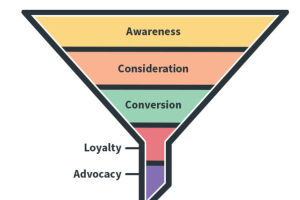The relationship between marketing and the customer buying journey has always been a historical topic of discussion. Previously in the 18th century, brands began to focus on understanding buyers’ viewpoints, and how they would react in different situations. By knowing the buyer’s psychology, marketers could determine what type of environment triggers the purchasing emotion in the buyer. After experimentation with this buying behavior, it became clear that marketing as a concept needs to be solely driven by consumer behavior. Eventually, every brand started developing its marketing plans according to the buying-behavior theory. Even now, the brands of the 21st century scan consumer buying behavior with a laser-like focus to set a successful marketing goal.
With every passing day, it is becoming more and more crucial for brands to mold their marketing approaches according to the marketing funnel. At every phase of the funnel, marketers are developing highly personalized marketing tactics. These tactics help an old brand stay relevant and retain customers in an era where customers are spoilt for choices. New-age brands are appealing buyers by understanding their emotional aspects at every stage. Each strategy is crafted according to the expected outcome of a stage in the funnel. By doing so, a brand maintains a balance between being aggressive or approachable as needed for a stage.
A tactic can go awry if a brand doesn’t craft a strategy based on the buyer’s stage. Marketing would then be directionless. To appeal to each of the customers, marketing tactics should be personalized across the buying journey. When a company creates personalized content and consumer interest-focused strategies, potential customers get attracted to the approach. Later on, they start to feel a significant connection with the brand and are more likely to pay complete attention to the brand’s next move. This inbound marketing is a highly chosen method, suggesting that brands should create long-term relationships with their customers.
The Buying Stages
Here are the much-talked about marketing stages that are focused on the behavior of a customer. Each stage purely illustrates the psychology of a customer and their emotions when they get to know about a brand.
Image Credit : Sprout social
Awareness
The very first stage of the buying process isn’t overly pushy or overbearing. This preliminary stage aims to provide prospects with information about who a brand is and what it stands for! During this process, a customer learns about the brand, what products it offers, and what benefits it can deliver. Here, awareness is created in such a way that a customer starts feeling an emotional connection with the brand. Once a brand communicates how it can ease a customer’s pain, the further road becomes easy. In awareness, two things matter: target audience and audience reached. Targets are chosen based on geographical, behavioral, and different other kinds of segmentation. Whereas the audience reached is measured on the basis of likes, website traffic, or page views. Later on, these mere views turn out to be potential leads for the brand.
Consideration Stage
At this stage, a customer is little aware of the product. Inside a buyer’s mind, the person wonders whether the product is needed and how it can solve a problem. Speaking from a brand’s perspective, the goal here is to assist buyers in every possible way so that they remain in the sales pipeline for the next stage – conversion. In this stage, the main focus of a brand is to put buyers’ dilemmas to an end by providing them with the solution to their needs/problems. The act of softly delivering a brand’s value and worthiness is what consideration is all about.
More than the purchase, actions matter in this stage. Whether it is someone adding a product to a cart or anyone signing up to any website, every action counts. However, it takes a long time to get these actions converted into consideration, as consideration is based on trust. The trust can be built through communicating the brand value and providing the solution to the need.
Conversion
Normally, brands become so obsessed with traffic that they often underestimate the conversion process. Getting leads and views was the second step based on the buyer’s journey. In order to convert these leads into sales, brands need to work extra hard, as getting customers to pay for the product takes extra effort. When it comes to conversion, customers prefer brands that have a direct intent to sell rather than ones that go round and round with their words. For instance, a direct message to make a transaction could be a pop-up for a subscription or an offer with Amazon Prime.
However, the focus of a brand should be to make the customer’s journey easier by avoiding complexity in the payment process, product configuration, and process complications. When this is achieved, there’s no stopping. Conversions will become significantly easier than before.
Loyalty
Customers are the gems, and loyal customers are the entire treasure. But finding customer loyalty is not always easy. Out of five, only one buyer is likely to be faithful because the trait ‘loyalty’ carries a lot of expectations. Loyalty or repurchase happens if a customer likes a product, finds the purchase journey free of any hurdles, and is satisfied with the brand’s performance. In this situation, a brand should maintain contact to establish a connection. This is the space for the customer service team to step in. This vertical in an organization is the face of the brand. Its efficiency in resolving customer problems results in customer satisfaction. Once this satisfaction reaches its peak, loyalty enters!
Advocacy
Customers are the unofficial spokesperson of a brand. They willingly spend the time and root for their favorite brand. Followed by loyalty, advocacy plays a huge role in influencing people’s decisions. Today, half the population relies on referrals and recommendations to make decisions. An endorsement (word of mouth) from peers or colleagues has the capacity to make or change a buying decision of another prospect. This act helps sales and brand image. These advocates are the assets of the brand because they support the brand no matter what. That’s why every brand pays close attention to advocates. At this stage, the psychology of a customer is usually about expecting recognition from the brand. Whether through giveaways, or social media mentions, customers expect that brands will consider them as more than an extra. When this happens, the engagement meter goes up.
The Techniques of Promotion Across the Buying Journey
Promotions have always been a vital part of marketing. If marketing is tailored as per the buyer’s journey, promotion should follow the same approach. Currently, from Apple to Zara, every brand is reshaping its way as per the buyer’s journey. The reason is simple: customers adore it when a brand does something according to their desire. A brand needs to go deep and examine what each stage demands. Customers just don’t wake up and say that they want to know about a brand or its loyalty services. That’s something every brand has to identify and take care of during promotions.
For successful promotion, brands use different types of tactics. Here are a few that will serve as assets to every brand along the way.
Send an email
A customer may receive an email from an online marketplace where the person might have put some products in the cart and left the store. Despite the fact that they may sound like normal notifications, these emails are attention-grabbing. The sole motive of these emailers is to bring customers close to the end goal, whether it’s payment or subscribing. Keeping in mind the stage of the buyer, these emails are designed in a way to trigger the emotions of the customer.
Write a Blog
One of the most educational ways to interact with the audience is through a blog. This informative method ties the reader with the accurate details and specifics they always lookout for. Most of the customers might have experienced many blogs where a brand opens up a conversation with a trend (15 best summer collections to have) and smoothly concludes mentioning the best seller on the site (latest summer jackets). We call that content engagement!
Conduct Webinars
In the digital age, webinars are becoming an active engagement tool. These digital forums can influence a large audience. One good example is TedTalks. In these webinars, the conversational content is made in such a way that it ultimately triggers the audience’s emotions. A brand of 2021 should not overlook the impact webinars have on a buyer’s journey.
Shoot Pre-roll ads
YouTube has given life to many brands. One pro technique is its pre-roll ads. The ads are the quickest way to get traffic. From Pepsi to Cadbury, every brand has taken advantage of pre-roll ads. This technique is a boon for mobile users, especially teenagers and young adults.
Content Marketing
Content marketing is that ace of spades that can influence the customer with mere letters. Today, more than 95% of brands believe that content is the new game in the market. It is the easiest way to bring an audience close to a purchase.
Subscription Model
Subscription is a bundle full of added features. This technique makes the customer feel special and valuable. Speaking of subscription as a technique, it can lure customers at every stage of their purchasing process. Till date, this technique has brought many customers with a long-term vision to stick with the brand.
The Rewards
Starting from the 19th century, the technique of rewards has come a long way. From the world’s first reward program called frequent flier to Starbucks loyalty cards, this marketing technique can capture some of the best customers for the brands. Even now, it perfectly blends into every after-sales practice.
Hashtags
Hashtags are not to be forgotten! From latest trends to what’s new with the brand, a hashtag carries everything. They are vital to the social media experience of every millennial today. It’s one of the smart ways to drive the insane traffic. This technique has the potential to significantly increase a brand’s position in the market if used correctly.





